#ebony lutung
Explore tagged Tumblr posts
Text





















Monkey Day
Spend a day at the zoo with these cheeky creatures, throw a monkey-themed fancy dress party or fundraise to protect these precious primates.
Monkeys are interesting creatures – cute, mischievous, and sometimes downright obnoxious (anyone who disagrees has obviously never had their laundry torn down by a family of primates when it’s hanging to dry).
Many species of primates are also endangered, and then there are questions of animal rights and the usage of primates in medical research. That’s why there’s Monkey Day — a day that is dedicated to raising awareness about non-human primates.
How to Celebrate Monkey Day
You could simply dress up in a monkey costume and play the part, because there are some people who do just that for Monkey Day and even hold competitions for it.
Spend Monkey Day at the Zoo
Head out to the zoo on this day, because many zoos around the world hold special celebrations for Monkey Day.
Some of these events focus on educational events about monkeys, while others do things like auction off artwork created by chimps and performing intelligence tests on primates.
Even if a local zoo in your area is not hosting an event on this date, we would definitely recommend taking a trip to a zoo and spending some time with the animals.
Attend Special Monkey Day Events
Make sure you take a look at their calendar beforehand, as many have special activities and talks going on.
For example, at Australia’s National Zoo & Aquarium, they hold a number of educational talks and activities that are designed to raise money for endangered species, such as Cotton-top Tamarins in Columbia, as well as increasing awareness.
In Scotland, at the famous Edinburgh Zoo, they raise awareness about the different dangers that primates face by using monkey storytelling.
Monkey Day events are also held at The Faruk Yalçın Zoo and Botanical Park in Darıca, Turkey to raise awareness.
In India, the Indira Gandhi Zoological Park holds a number of different programs so that children can become educated about issues facing wildlife and so that people are encouraged to adopt monkeys. The list doesn’t end there either.
In Pakistan, the Lahore Zoo really goes the extra mile. They hold educational events and art competitions about monkeys, including performances to highlight the threats they face, poetry readings about monkeys, and much more.
Host a Monkey Day Gathering
Consider throwing a Monkey Day party by inviting all of your friends over, perhaps dressed as favorite primates.
Enjoy common activities like watching monkey-themed films such as King Kong, Planet of the Apes, and Lady Iron Monkey, as well as monkey-themed music (The Monkees, anyone?).
Support Monkey Charities
Often, celebrations involve fundraising for primate-related causes and charities, and many organizations around the world dedicated to primates hold Monkey Day events of various sorts.
So when Monkey Day comes around, get out there and do it proper, by monkeying around!
Watch a Monkey Film
Another way to celebrate Monkey Day is by watching a film based on this primate! There are so many different types of monkey films. Of course, the Planet of the Apes series of films is the most well-known, but there are many others.
Disney’s Monkey Kingdom comes highly recommended. Other famous monkeys on screen include the Chain-Smoking Capuchin in The Hangover Part II, Clyde in Every Which Way But Loose, Cheeta in Tarzan the Ape Man, George in Curious George, Joe in Mighty Joe Young, and King Louie in The Jungle Book.
Learn About Monkey Day
Monkey Day was founded to celebrate monkeys, as well as “all things simian,” which includes lemurs, tarsiers, apes, and other non-human primates.
It is a great day when it comes to raising awareness about different types of monkeys and primates around the world, as well as the issues they face and how we can help them.
Environmental activists and animal rights activities are especially vocal and passionate about this date. The same goes for art institutions and visual artists.
Supporters of this date have included the Smithsonian Institution, the Metropolitan Museum of Art, the Louvre Museum in Paris, London’s National Portrait Gallery, National Geographic, Greenpeace, and Jane Goodall.
History of Monkey Day
While celebrating this animal is an excellent way to get invovled in the day, the origins are a bit unexpected. Back in 2000, Casey Sorrow was an art student at Michigan State University, and he ended up writing “Monkey Day” on his friend’s calendar as a prank.
But then they actually celebrated the occasion with other art students at MSU, and Sorrow later started collaborating with fellow MSU student on the Fetus-X comic strip, where the holiday was mentioned and popularized.
Since then, Monkey Day has been grown in popularity as a day to celebrate primates (including monkeys, but also apes, lemurs, and tarsiers).
Sorrow himself still does much to promote the holiday and the cause of primate welfare, and in addition to the Monkey Day website, he also maintains a “Monkeys in the News” blog which discusses primate-related news around the world and comes out with a list of the top ten primate-related news stories from the past year every Monkey Day.
Since Monkey Day was founded, it really has gone from strength-to-strength. It is now celebrated in many different corners of the world.
This includes Scotland, Turkey, Thailand, Colombia, the United Kingdom, Estonia, Pakistan, India, Germany, and Canada. It has been described by the Washington Post as a day to do the following:
“Learn something about these adorable and highly intelligent primates. Or you could use this day to act like a monkey.”
Monkey Day Timeline
2nd Century AD
Claudius Galenus studies monkeys
In the early days of pioneering medicine Galenus (known as Galen) studied monkeys through dissection, noticing their similarities to humans.
1939
Flying monkeys are featured in film Wizard of Oz
In a strange and frightening portion of the plot, monkeys with wings act as minions released by the Wicked Witch of the West to scare off Dorothy and her friends.
1941
Curious George makes debut in books
As monkeys begin appearing in films and books, one of the most endearing monkeys will last in popularity for at least 80 years–Curious George. Although there are only 7 books in the original series by H. A. Ray, the character lives on through an animated television show, videos and even a 2006 feature film.
1959
First monkey in space
A squirrel monkey, Miss Baker, and a rhesus macaque, Able, were the first monkeys who made a successful launch and return to space. They were sent by the United States Air Force on a Jupiter rocket.
2000
Monkey Day begins
As a little joke, Casey Sorrow, a Michigan State University art student, wrote “Monkey Day” on a friend’s calendar just to be silly. Then, in more silliness, they decided to go ahead and celebrate the day with other art students. Later, Casey Sorrow became the co-creator of the weekly Fetus-X comic strip, which was used to promote the day.
Monkey Day FAQs
How did Monkey Day inspire unique art exhibitions?
Artists Casey Sorrow and Eric Millikin, co-creators of Monkey Day, have integrated the theme into various art forms.
For instance, in 2012, Millikin presented “The 12 Stars of Monkey Day,” a series inspired by pioneering space monkeys.
Such exhibitions blend creativity with primate appreciation.
What are some unusual Monkey Day traditions worldwide?
In Estonia, Tallinn Zoo auctions chimpanzee-created art and conducts intelligence tests on Japanese macaques.
In Pakistan, Lahore Zoo hosts events with children wearing monkey masks and performing related poetry.
How has Monkey Day influenced film releases?
Peter Jackson’s “King Kong” premiered on December 14, 2005, aligning with Monkey Day. This timing connected the film’s theme with the day’s celebration of primates.
Are there any myths associated with Monkey Day?
A playful myth suggests that monkeys causing mischief, like a monkey driving a stolen bus, are honoring Monkey Day traditions. This highlights the day’s lighthearted nature.
How do animal rights organizations participate in Monkey Day?
Groups like Greenpeace use Monkey Day to promote primate habitat protection, encouraging actions such as becoming a forest defender.
What role does Monkey Day play in fundraising efforts?
Celebrations often include fundraising for primate-related causes. For example, in 2008, art shows and auctions benefited animal sanctuaries, featuring human and chimpanzee works.
How do different cultures celebrate Monkey Day?
In India, the Indira Gandhi Zoological Park educates children about wildlife and encourages monkey adoption. In Turkey, the Faruk Yalçın Zoo raises awareness about declining monkey populations.
What are some creative ways people engage with Monkey Day?
Some enthusiasts host monkey-themed costume parties, complete with competitions and monkey impersonations, adding a fun twist to the celebration.
How has Monkey Day been recognized by prominent figures?
Renowned primatologist Jane Goodall has acknowledged Monkey Day, highlighting its significance in promoting primate awareness.
What are some misconceptions about Monkey Day?
Some might think it’s an ancient tradition, but Monkey Day began in 2000, initiated by art students as a humorous observance that gained international traction.
Source
#Gelada Baboon#Bronx Zoo#my favorite zoo#New York City#animal#USA#summer 2018#2019#original photography#nature#flora#fauna#travel#vacation#Monkey Day#MonkeyDay#14 December#Angola colobus#Mandrillus sphinx#Mandrill#Wolf's mona monkey#Western lowland gorilla#Congo Gorilla Forest#ebony lutung#Silvery lutung#Javan lutung#Zoo Zürich#Zurich#Switzerland#Schweiz
5 notes
·
View notes
Text
Sun clan AU character directory
[this directory will be edited and updated as time goes on and the story progresses]

THE ELDERS: older generation, live on the deeper chambers of the Shuilian Mansion and enjoy the respect and honors by all the beings in Huaguoshan.
An-kong Tudigong (Grandpa Earth God)
Earth God of Huaguoshan, appears mostly as a moss-green furred orangutan but has many forms. Reclusive and reticent, but loves dearly all the beings living on his mountain. Adoptive father of Wukong.
A-ma Longan (Grandma Dragon-Eye)
Matriarch of a monkey troop, Francois Langur. Dry yet caring, often serves as a protector of the monkeys of the mountain and a middleman between spirits and mortal creatures. Her duties were mostly taken over by Wukong after he became king. Adoptive mother of Wukong.
I-bo Lanye (Auntie Orchid-leaves)
Granddaughter of Longan, and second in command, Silvery Lutung. Fond and overbearing, takes care of the troop whenever Longan leaves to maintain the peace. Biological mother of Jinju.
Shandanmao (Coral lily cat), also called Au-bo Shanhu (Stepmom Coral)
An asian golden cat who once attempted to eat Longan, and was made to atone for her attack on the mountain's Tudipo by serving as her bodyguard.
Wukong, also called Shihou (Stone Monkey) and Xiaoshi (Little pebble)
King of Huaguoshan. Rules over several troops that live on the mountain and shelter in the Water-Curtain Cave, and helps to keep the peace and balance among the creatures and demons.
THE FOUR STALWART MARSHALS: The Monkey King's trusted second-in-commands in the kingdom's hierarchy, and Wukong's closest confidants.
Liu Jinju (Golden-Orange)
Ma Yuehua (Moon-Flower)
Ba Hongteng (Red-vine)
Beng Maqaw (Mountain-pepper)
THE GOLDEN CAPTAINS: Trusted soldiers directly under the command of the Stalwart Marshals, but especially under Jinju/Marshal Liu
Songzhen (Pine-needles)
Second-oldest of the group, a laidback Ebony Javan Langur.
Suanguo (Sour-fruit)
The youngest and grumpiest of the bunch, a red-shanked douc.
EXTENDED FAMILY: Members of the sworn brothers' kingdoms who end up joining Huaguoshan in some manner.
Erwangzi Xiangjing (Second Prince Fine-Fragrance), also known as Prince Rougui (Cinnamon)
Wukong's mate and trusted friend, Cat Ba langur. One of the rescued monkeys from the Monstrous King of Havoc's lair, trusted advisor and cousin-in-law of Yurong Wang (Golden Snub-nosed Monkey King). Charming, eloquent and wise, but wears his heart right on his sleeve. After the two kings build an alliance, Xiangjing and Wukong become quite fond of each other, and after some failed courting attempts, Wukong accepts Xiangjing's affections.
Rinrin, also called Xiaohuo (Little fire)
Ranked sentry and scout, Rhesus Macaque demon. Once part of Niu Mowang's kingdom, she sought to earn further rank and merit by learning exorcism techniques to dispel minor demons who'd dwell on the edges of the mountains. She became emotionally attached to a human demon hunter, and when she left the mountain in shame, said human followed her. She earned the friendship of Wukong swiftly, which also earned her a spot in his court despite displeasing the Bull Demon.
Xiaojie Duan
Skilled demon hunter, human. While she's accomplished in exorcising and conquering demons and spirits, her true goal was to find someone she loved to settle down and raise a family with. What luck, that said person turned out to be a demon monkey in disguise! Not one to back down from her affections, she followed after Rinrin and together they settled in Huaguoshan.
THE SEVEN PRINCELINGS: Wukong's children by order of age.
Wumiao (Witch-sprout)
Adopted first daughter, fairy crane demon. Eternally youthful and ethereally beautiful lady. Often bears a feathered fan in her hand and a pinewood sword at her waist. Gentle and demure, adores her father and siblings. Head priestess of the Huaguoshan Daoist temple, and protectress of the Heavenly gate there.
Bailian (White-face)
The largest of the quintuplets, Bailian has snow-white pale skin no matter the season or weather, and fur like clouds at dusk. Despite being the firstborn son and the only one able to walk on clouds and water, Bailian has frail health and a sickly disposition, and thus seldom interacts with the world at large. His father and siblings tend to be overprotective due to this, much to his dismay.
Liangwei (Two-tails)
The second daughter, Liangwei has a head of golden fur and two prehensile tails. She has a cunning mind and a sharp tongue, always quick to reply and twist people into knots with her words. She enjoys entertaining guests and kindred with masterful poetry and rhymes, as much as others enjoy hearing her. Her eyesight is quite poor, and she often relies on Sanyan and her tails to help her find her way around.
Sanyan (Three-eyes)
Second-born son, with a somber and dry temperament. Though his appearance seems at first not to stand out against his more visibly magical siblings, Sanyan possesses a third eye often hidden in his fur when closed. It can see the true nature of all things, though what he knows he seldom shares. Sanyan is selectively mute, and communicates through sign language or by borrowing Liangwei's sharp tongue when she's around.
Shuashua (Playful):
Third son among the five, and by far the most energetic. Most well known as a never-still blur, Shuashua is nimble and covered in colorful stripes of fur and has a snub nose. He's known for never sleeping or ever seeming to rest at all, and spending most of his time with some activity or another. Not the sharpest tool in shed, but his bright and hard-working disposition more than makes up for it.
Si'er (Four-ears)
Third daughter, and by all measures the runt of the quintuplets. She has a calm and sweet disposition, but her particularity of having four calf-like ears and sensitive hearing often tends to put off the others of her family and kingdom. Reincarnation of [redacted], aware of past life. Deeply devoted daughter and sister, tries her best to right the wrongs of the past. Has terrible tinnitus and migraines that turns her physically monstruous. Keeper of the sealed temple of [redacted].
Danxia (Cinnabar Cloud)
Adopted fourth son, human. An orphan left in Wumiao's temple. Despite growing up surrounded by demons, immortals, and fairies, the boy had no contempt for his peers, instead striving to learn as much as he could to keep up with his siblings.
THE KING'S DISCIPLES: newcomers to Huaguoshan after the fire, brought in thanks to the pilgrimage west.
Xiaoyu (little fish), Congcong (verdant), Jiazao (hearth)
Three female macaques Wukong rescued from being stable monkeys, and have stuck to the group to cater to the artifacts and run minor errands. Trained in combat by Wukong, and later joined the mountain kingdom as warrior nuns and established a Buddhist temple.
41 notes
·
View notes
Photo
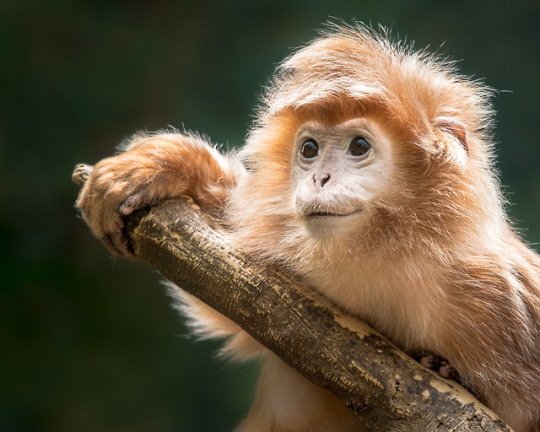
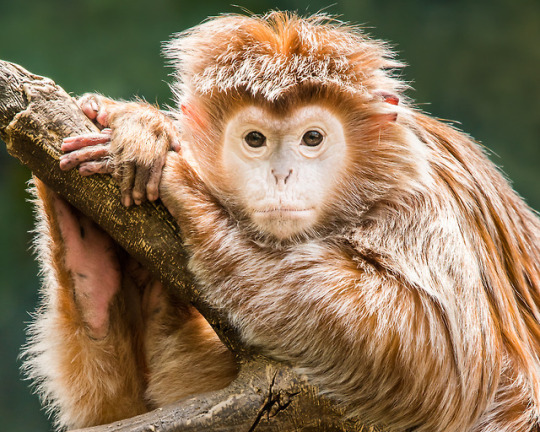
EBONY LANGUR (by Abeselom Zerit)
145 notes
·
View notes
Photo
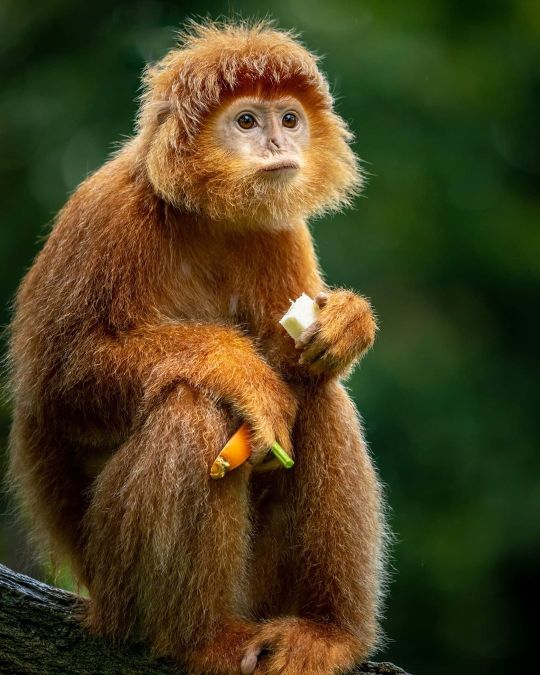
The East Javan Langur Also known as the ebony lutung, it is found on and endemic to the island of Java, as well as on several of the surrounding Indonesian islands. The menu of the Javan langur consists of leaves and flowers, making them herbivorous. They also consume fruit and insect larvae. 📷 : Sony ILCE-A7RM4, FE 100-400mm F4.5-5.6GM ##### 東爪哇葉猴 它也被稱為烏木魯通,在爪哇島以及周圍的幾個印尼島嶼上都很常見。 爪哇葉猴的菜單由葉子和花朵組成,使其具有草食性。 他們還食用水果和昆蟲的幼蟲。 (at Singapore) https://www.instagram.com/p/CD5QRNznz2l/?igshid=i7io478a5qyb
0 notes
Photo
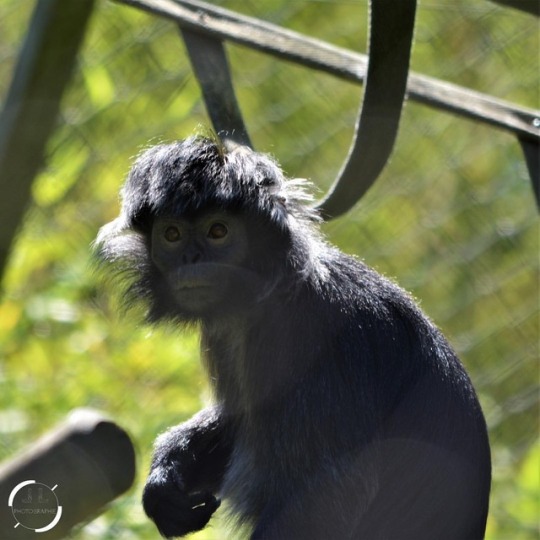
Fr: Langur de Java ou Semnopithèque noir En: Javan lutung also known as the ebony lutung and Javan langur De: Schwarzer Haubenlangur Nl: Javaanse langoer #llphoto #zoo #tregomeur #zootregomeur #zooparc #stbrieuc #bretagne #france #frankreich #frankrijk #animal #primate #java #javan #javaans #langur #noir #black #green #haubenlangur #schwarz #langoer #ebony #lutung #asia #tierpark #asiatique (à ZooParc de Trégomeur)
#llphoto#lutung#black#france#langur#primate#javan#bretagne#javaans#noir#green#asia#java#langoer#schwarz#haubenlangur#asiatique#animal#tregomeur#tierpark#zootregomeur#zoo#zooparc#frankrijk#stbrieuc#ebony#frankreich
0 notes
Photo

1 note
·
View note
Photo

Javan Lutung (Trachypithecus auratus) (by Joachim S. Müller)
#Javan Lutung#Lutung#Javan Langur#Ebony Lutung#Langur#Old World Monkey#Monkey#Primate#Mammal#Animal#Animals
95 notes
·
View notes
Photo







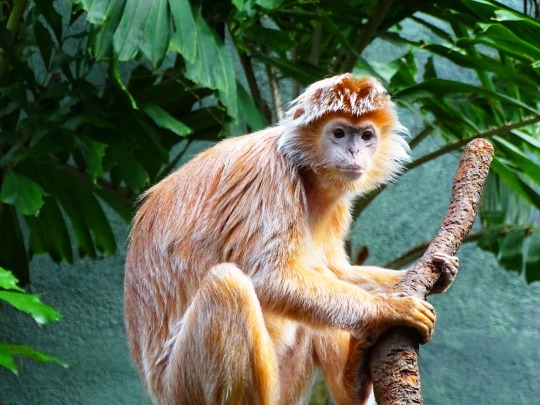


Monkey Day
Spend a day at the zoo with these cheeky creatures, throw a monkey-themed fancy dress party or fundraise to protect these precious primates.
Monkeys are interesting creatures – cute, mischievous, and sometimes downright obnoxious (anyone who disagrees has obviously never had their laundry torn down by a family of primates when it’s hanging to dry). Many species of primates are also endangered, and then there are questions of animal rights and the usage of primates in medical research. That’s why there’s Monkey Day, a day that’s been dedicated to raising awareness about non-human primates.
Learn about Monkey Day
Monkey Day has been created to celebrate monkeys, as well as “all things simian,” which includes lemurs, tarsiers, apes, and other non-human primates. It is a great day when it comes to raising awareness about different types of monkeys and primates around the world, as well as the issues they face and how we can help them.
Environmental activists and animal rights activities are especially vocal and passionate about this date. The same goes for art institutions and visual artists. Supporters and celebrates of this date include the Smithsonian Institution, the Metropolitan Museum of Art, the Louvre Museum, London’s National Portrait Gallery, National Geographic, Greenpeace, and Jane Goodall.
History of Monkey Day
Back in 2000, Casey Sorrow was an art student at Michigan State University, and he ended up writing “Monkey Day” on his friend’s calendar as a prank. But then they actually celebrated the occasion with other art students at MSU, and Sorrow later started collaborating with fellow MSU student on the Fetus-X comic strip, where the holiday was mentioned and popularized. Since then, Monkey Day has been observed internationally as a day to celebrate primates (including monkeys, but also apes, lemurs, and tarsiers).
Sorrow himself still does much to promote the holiday and the cause of primate welfare, and in addition to the Monkey Day website, he also maintains a “Monkeys in the News” blog which discusses primate-related news around the world and comes out with a list of the top ten primate-related news stories from the past year every Monkey Day.
Since Monkey Day was created, it really has gone from strength-to-strength. It is now celebrated in many different corners of the world. This includes Scotland, Turkey, Thailand, Colombia, the United Kingdom, Estonia, Pakistan, India, Germany, and Canada. It has been described by the Washington Post as a day to do the following:
“Learn something about these adorable and highly intelligent primates. Or you could use this day to act like a monkey.”
Monkey Day Timeline
2nd Century AD Claudius Galenus studies monkeys
In the early days of pioneering medicine Galenus (known as Galen) studied monkeys through dissection, noticing their similarities to humans.
1939 Flying monkeys are featured in film Wizard of Oz
In a strange and frightening portion of the plot, monkeys with wings act as minions released by the Wicked Witch of the West to scare off Dorothy and her friends.
1941 Curious George makes debut in books
As monkeys begin appearing in films and books, one of the most endearing monkeys will last in popularity for at least 80 years–Curious George. Although there are only 7 books in the original series by H. A. Ray, the character lives on through an animated television show, videos and even a 2006 feature film.
1959 First monkey in space
A squirrel monkey, Miss Baker, and a rhesus macaque, Able, were the first monkeys who made a successful launch and return to space. They were sent by the United States Air Force on a Jupiter rocket.
2000 Monkey Day begins
As a little joke, Casey Sorrow, a Michigan State University art student, wrote “Monkey Day” on a friend’s calendar just to be silly. Then, in more silliness, they decided to go ahead and celebrate the day with other art students. Later, Casey Sorrow became the co-creator of the weekly Fetus-X comic strip, which was used to promote the day.
How to celebrate Monkey Day
You could simply dress up in a monkey costume and play the part, because there are some people who do just that for Monkey Day and even hold competitions for it. Or you could spend the day at the zoo, because many zoos around the world do hold special celebrations for Monkey Day. Some of these events focus on educational events about monkeys, while others do things like auction off artwork created by chimps and performing intelligence tests on primates.
Even if a local zoo in your area is not hosting an event on this date, we would definitely recommend taking a trip to your nearby zoo and spending some time with the animals. Make sure you do take a look at their calendar beforehand, as zoos all around the world have special activities and talks going on. For example, at Australia’s National Zoo & Aquarium, they hold a number of educational talks and activities that are designed to raise money for endangered species, such as Cotton-top Tamarins in Columbia, as well as increasing awareness.
In Scotland, at the famous Edinburgh Zoo, they raise awareness about the different dangers that primates face by using monkey storytelling. Monkey Day events are also held at The Faruk Yalçın Zoo and Botanical Park in Darıca, Turkey to raise awareness. In India, the Indira Gandhi Zoological Park holds a number of different programs so that children can become educated about issues facing wildlife and so that people are encouraged to adopt monkeys. The list doesn’t end there either. In Pakistan, the Lahore Zoo really goes the extra mile. They hold educational events and art competitions about monkeys, including performances to highlight the threats they face, poetry readings about monkeys, and much more.
Even if you don’t have a monkey at your house, you might consider throwing a monkey day party, inviting all of your friends over (keep in mind that humans are in fact primates too, even without gorilla costumes), and common activities at such celebrations involve films such as King Kong, Planet of the Apes, and Lady Iron Monkey, as well as monkey-themed music (The Monkees, anyone?).
Often, celebrations involve fundraising for primate-related causes and charities, and many organizations around the world dedicated to primates hold Monkey Day events of various sorts. So when Monkey Day comes around, get out there and do it proper, by monkeying around!
Finally, another way that you can celebrate Monkey Day is by watching a film based on this primate! There are so many different types of monkey films. Of course, the Planet of the Apes series of films is the most well-known, but there are many others. Disney’s Monkey Kingdom comes highly recommended. Other famous monkeys on our screens include the Chain-Smoking Capuchin in The Hangover Part II, Clyde in Every Which Way But Loose, Cheeta in Tarzan the Ape Man, George in Curious George, Joe in Mighty Joe Young, and King Louie in The Jungle Book.
Source
#Gelada Baboon#Wolf's mona monkey#2019#Bronx Zoo#New York City#my favorite zoo#indoors#original photography#animal#travel#vacation#tourist attraction#landmark#Mandrillus sphinx#outdoors#ebony lutung#Western lowland gorilla#Black-and-white colobus#Monkey Day#19 December#InternationalMonkeyDay#I really love the first pic
6 notes
·
View notes
Photo
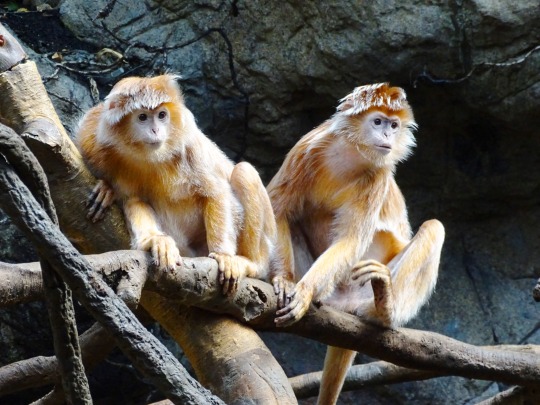
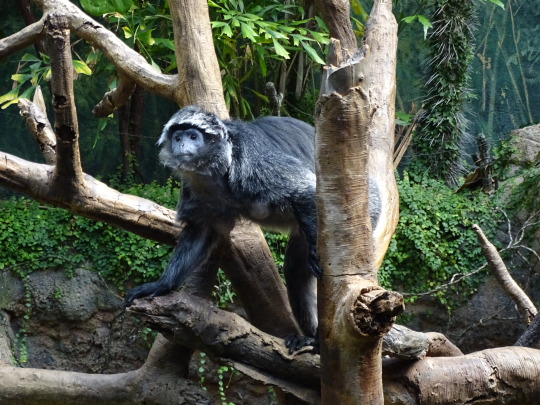





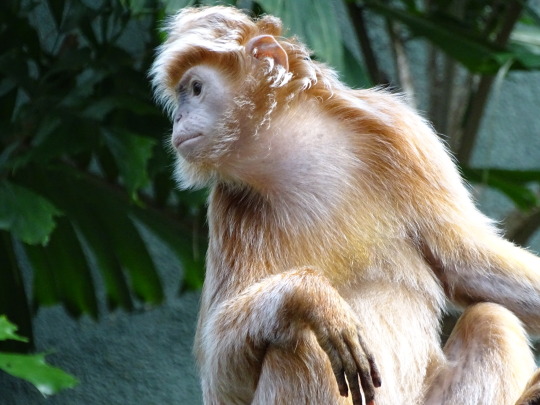
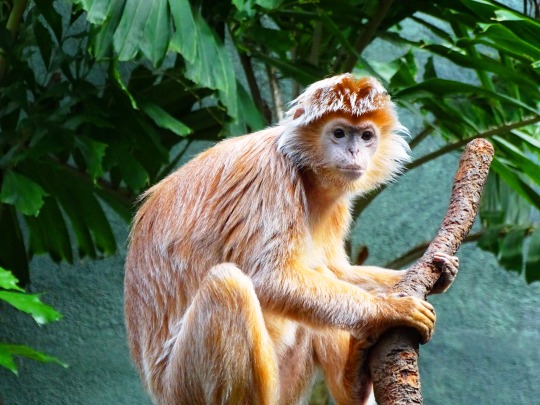

Bronx Zoo, New York City (No. 43)
The East Javan langur (Trachypithecus auratus), also known as the ebony lutung, Javan langur or Javan lutung, is an Old World monkey from the Colobinae subfamily. It is most commonly glossy black with a brownish tinge to its legs, sides, and "sideburns". It is found on and endemic to the island of Java, as well as on several of the surrounding Indonesian islands. The Latin word auratus in its scientific name means "golden", and refers to a less common color variant. Note that the common name golden langur is used for a different species.
Like all langurs, this species' tail is noticeably long, measuring up to 98 cm in length while the body is only around 55 cm long. The two subspecies of this lutung are fairly similar in appearance and are geographically separated; males and females are both usually glossy black, although the females pale, yellowish white patch around the pubic area. Juveniles of both subspecies are orange in color. The nominate subspecies Trachypithecus auratus auratus has a rare morph that does not lose its juvenile coloration when it matures, instead the coloration darkens slightly, with yellow tinges on its sides, limbs, and around its ears, and a black tinge on its back.
The East Javan langur inhabits the interior and peripheral areas of rainforests.
This primate is diurnal and arboreal. Its diet is primarily herbivorous, eating leaves, fruit, flowers, and flower buds, although it also eats insect larvae. As with other colobines, it has evolved a specialised stomach to digest plant material more efficiently. This species also has enlarged salivary glands to assist it in breaking down food.
Like other langurs, the East Javan langur is a social animal, living in groups of around seven individuals, with one or two adult males in the group.[3] Although they will look after offspring of other mothers as well as their own, adult females are aggressive towards females from other groups. The brighter coloring of juveniles may alert females to their presence and ensures that they will always be noticed and protected. This species has no discernible mating season and females produce one offspring at a time.
Source: Wikipedia
#Bronx Zoo#my favorite zoo#JungleWorld#Total Experience attraction#USA#animal#flora#fauna#original photography#summer 2108#New York City#Wildlife Conservation Society#WCS#close up#detail#East Javan langur#ebony lutung#Silvery lutung#silvered leaf monkey#silvery langur#vacation#Old World monkey#Bronx#indoors#tourist attraction#landmark#shrub#nature
1 note
·
View note
Photo

Angry, Bronx Zoo
What do you think about my pic?
#Silvery lutung#Javan lutung#ebony lutung#Old World monkey#animal#original photography#Bronx zoo#New York City#summer 2018#usa#travel#I'll be back next summer#tourist attraction#vacation#tree#flora#fauna#Ebony Langur#JungleWorld#What do you think about my pic?#road trip
0 notes